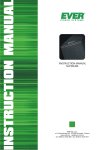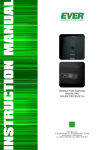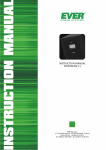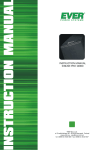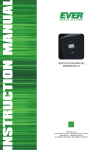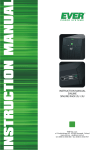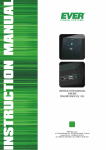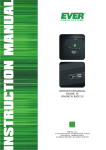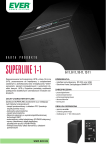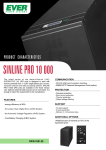Download Ever Poweline 33 10kVA/7.5kW
Transcript
Instruction manual for POWERLINE 33 series UPS TABLE OF CONTENTS TABLE OF CONTENTS........................................................................................................................................ 2 INTRODUCTION .................................................................................................................................................. 3 GENERAL INFORMATION ................................................................................................................................. 3 INTENDED APPLICATION............................................................................................................................. 3 GENERAL DESCRIPTION .............................................................................................................................. 3 UPS STRUCTURE ................................................................................................................................................. 5 USER INTERFACE........................................................................................................................................... 6 PAGES ............................................................................................................................................................... 8 Main menu .............................................................................................................................................................. 9 POMIARY submenu............................................................................................................................................... 9 KONTROLA submenu ......................................................................................................................................... 14 KONFIGURACJA submenu................................................................................................................................. 16 ALARMY submenu.............................................................................................................................................. 18 STATYSTYKA submenu ..................................................................................................................................... 19 USTAWIENIA PANELU submenu...................................................................................................................... 21 IDENTYFIKACJA submenu ................................................................................................................................ 22 ZDARZENIA submenu ........................................................................................................................................ 23 HEALTH AND SAFETY ..................................................................................................................................... 24 TRANSPORT................................................................................................................................................... 24 ELECTRICAL SAFETY ................................................................................................................................. 24 INSTALLATION.................................................................................................................................................. 25 UNPACKING .................................................................................................................................................. 25 ASSEMBLY .................................................................................................................................................... 26 BATTERY PACK (optional) ........................................................................................................................... 26 Connection of modules ......................................................................................................................................... 27 Disconnection of modules..................................................................................................................................... 28 CONNECTING THE UPS............................................................................................................................... 29 Connection Terminals ........................................................................................................................................... 29 Electric installation ............................................................................................................................................... 30 START (power from mains) ................................................................................................................................. 31 START (no power from mains) ............................................................................................................................ 31 TURN OFF AND DISCONNECT........................................................................................................................ 32 OPERATION MODES .................................................................................................................................... 32 OTHER FUNCTIONAL COMPONENTS ...................................................................................................... 35 Protection .............................................................................................................................................................. 35 EPO .................................................................................................................................................................. 37 MANUAL BYPASS ........................................................................................................................................ 37 WORK WITH COMPUTERS .............................................................................................................................. 38 USB AND RS232 COMMUNICATION ......................................................................................................... 38 SNMP/HTTP NETWORK MANAGEMENT CARD ..................................................................................... 38 Card installation .................................................................................................................................................... 39 POWERSOFT PERSONAL INSTALLATION AND CONFIGURATION ................................................... 40 Windows ............................................................................................................................................................... 40 Linux/Unix............................................................................................................................................................ 40 Software update .................................................................................................................................................... 41 COMMENTS ON OPERATION.......................................................................................................................... 42 WORK WITH POWER GENERATORS ........................................................................................................ 42 STORAGE, MAINTENANCE, AND TRANSPORT...................................................................................... 43 UTILISATION................................................................................................................................................. 43 TECHNICAL PARAMETERS............................................................................................................................. 44 INSTALLATION GUIDELINES .................................................................................................................... 44 TECHNICAL DATA ....................................................................................................................................... 45 LEGAL REGULATIONS AND THE GUARANTEE ......................................................................................... 46 DECLARATION OF CONFORMITY ............................................................................................................ 46 2010/06/22 www.ever.eu 2 Instruction manual for POWERLINE 33 series UPS INTRODUCTION Thank you for purchasing EVER POWERLINE 33 – an advanced UPS series dedicated to servers, computer networks, and data processing systems. UPS EVER POWERLINE 33 is designed to meet all of your expectations related to protection against power outages in the best way. This manual contains information on how to operate and maintain the unit safely. Thoroughly familiarise yourself with the EVER POWERLINE 33 manual before the first use to ensure that it is operated properly. The unit is manufactured in Poland, in compliance with the CE requirements. GENERAL INFORMATION INTENDED APPLICATION POWERLINE 33 units are on-line (VFI) class devices that are intended to work with equipment powered from ~230V three-phase mains. POWERLINE 33 units are dedicated to very sensitive receiver devices. They generate output voltage with benchmark-quality parameters. The units feature high short-circuit current allowing for the high selectivity of grid protection. The units are equipped with an event log that is available to users via the embedded LCD. The unit features high efficiency in ECO mode and a wide selection of input current options in the hybrid mode. NOTE! POWERLINE 33 power supply units are not intended for use with medical equipment to support life and/or health. GENERAL DESCRIPTION Main features: • High short-circuit current • Integrated LCD operator panel • Advanced battery charging algorithm • Extended management options • Optional additional battery packs • Hybrid mode • Event log • ECO mode • “Cold” and “soft” start 2010/06/22 www.ever.eu 3 Instruction manual for POWERLINE 33 series UPS POWERLINE 33 components include: • battery set • rectifier • inverter with high-frequency IGBT • automatic bypass (static) • manual (service) bypass (UPS/bypass manual switch) • microprocessor-based control system with measurement circuits Figure 1: Simple block scheme Input rectifier transforms alternating voltage from the input to direct current at the output, and charges the batteries at the same time. The DC bus is the basic power source for the inverter that generates alternating sine wave current that is used to feed the receivers. A microprocessor control system ensures the precision and reliability of the entire power supply system. An automated bypass system increases the overall system security. In the event of inverter failure, the current from the mains is provided directly to the load. The automated bypass system thus becomes an additional passive safeguard of the load. An additional manual bypass connection enables the complete switch of the load to the mains. The receivers are then backed up from the mains with the internal UPS modules bypassed. 2010/06/22 www.ever.eu 4 Instruction manual for POWERLINE 33 series UPS UPS STRUCTURE 1) Service bypass circuit 2) Input safeguard (F3, F4) 3) Input and output sockets 4) DC input safeguard (F5) optional 5) Cable fixtures 6) UPS fixtures 7) Internal battery safeguard (F1, F2) 8) Expansion card slot 9) EPO interface 10) USB port 11) RS232 port 12) Fans Figure 2: Rear panel 2010/06/22 www.ever.eu 5 Instruction manual for POWERLINE 33 series UPS USER INTERFACE The user interface is a four-button keypad on the upper UPS casing, LCD, and three LEDs. It allows for the monitoring of the working parameters and their modification. The use of the interface and the specific parameters are described later on in this document. Figure 3: User interface Table 1 Signalling LEDs Graphical Symbol symbol LED 1 LED 2 LED 3 Description LED indicating UPS work mode: NORMAL/BACKUP LED indicating the activation of BYPASS LED indicating the EMERGENCY mode Table. 2 Visual signals (LEDs) LED 1 LED 2 LED 3 Mode UNKNOWN F NORMAL ECO F BYPASS BACKUP F STANDBY F E * * SUSPENDED * EMERGENCY F INIT F STOP HIBRID E – if EPO is started, then signals are turned off. Otherwise, emergency mode signalling is turned on. F – depends on configuration (none or red). * - blinking 2010/06/22 www.ever.eu 6 Instruction manual for POWERLINE 33 series UPS The unit also features sound alarms corresponding to the specific operational modes (table). Table. 3 Sound alerts Event REGULAR HIBRID BACKUP Sound None beeps that accelerate as the batteries empty until the sound becomes continuous Forced STANDBY two short beeps and a pause EMERGENCY depending on the type of event OVERLOAD continuous sound Short circuit short beeps and pauses (50/50) Overheating slow beeps and pauses (50/50) EPO start beeps and pauses (1 sec./5 sec.) All LCD pages are based on a tree hierarchy shown in the below figure. Figure 4: LCD page hierarchy 2010/06/22 www.ever.eu 7 Instruction manual for POWERLINE 33 series UPS PAGES SCREENSAVER Description: Information page that appears as a screensaver after 5 minutes of the last button being pressed. It turns off LCD illumination, as well. Type: read Parameters: Q - battery charge level U+ - hot battery cell (+) voltage U- cold battery cell (-) voltage Owy - battery load level Tau - expected backup duration TrybPracy - operation mode i: …, A: … - additional information according to the table General messages (i:) describe all the operation modes, except for EMERGENCY, which is signalled with emergency messages General messages Alerts Abbreviation Power supply Message Description i:Ladowanie Charging A:Zwarcie Short circuit F) i:PrzeciąŜenie Overload A:PrzeciąŜenie Overload F) i:PrzegrzanieProst Rectifier block overheating A:PrzegrzanieProst Rectifier block overheating P) i:PrzegrzanieFal Inverter block overheating A:PrzegrzanieFal Inverter block overheating F) i:OczekNaLadunekMin Waiting after STANDBY A:UszkAkumulatora Damaged batteries P) i:AkumulatorRozlad 90 s backup time left Periodic servicing recommended BYPASS active No communication with rectifier block No communication with inverter block Incorrect phase order in BYPASS Exceeded BYPASS parameters Open battery circuit Exceeded inverter block parameters A:EPO Emergency EPO F) A:BladWewProstownika Internal rectifier block error P) A:BladWewFalownika Internal inverter block error F) i:Serwis i:Bypass i:BrakKomProst i:BrakKomFal i:ZlaKolejnoscFazByp i:ZasBypPozaZakres i:OtwartyObwAku i:ZasProstPozaZakres F) message started by KasujAwarieFal (Configuration 3/4) P) message ended by KasujAwarieProst (Configuration 3/4) Screen: 2010/06/22 www.ever.eu 8 Instruction manual for POWERLINE 33 series UPS Main menu The main menu has three pages. The pages are navigated by pressing the ▼▲ buttons. Items are selected by pressing . Once selected, a submenu appears that can be navigated by using ▼▲. The arrow on the left side of the submenu name shows the current position. The selection must be confirmed by pressing . ESC moves one level up. POMIARY submenu The POMIARY submenu has two pages with five thematic groups: PROSTOWNIK, BYPASS, WYJSCIE, AKUMULATOR, TEMPERATURA. The menu is navigated similarly to the menu presented above. 2010/06/22 www.ever.eu 9 Instruction manual for POWERLINE 33 series UPS PROSTOWNIK 1/5 Description: UPS input parameters Type: read Parameters: ULn - rectifier input voltage for line n ILn - rectifier input current for line n Screen: PROSTOWNIK 2/5, 3/5, 4/5 Description: UPS input parameters Type: read Parameters: PLn - rectifier input active power for line n SLn - rectifier input apparent power for line n PFLn - rectifier input power factor for line n Screen: PROSTOWNIK 5/5 Description: UPS input parameters Type: read Parameters: P - total rectifier input active power S - total rectifier input apparent power f - rectifier input frequency (for line L1) Screen: 2010/06/22 www.ever.eu 10 Instruction manual for POWERLINE 33 series UPS BYPASS 1/5 Description: BYPASS input parameters Type: read Parameters: ULn - BYPASS voltage (line n) ILn - BYPASS current (line n) Screen: BYPASS 2/5, 3/5, 4/5 Description: BYPASS input parameters Type: Read Parameters: PLn - BYPASS input active power (line n) SLn - BYPASS input apparent power (line n) PFLn - BYPASS input power factor (line n) Per cent value – load level for line n. Screen: BYPASS 5/5 Description: BYPASS input parameters Type: read Parameters: P - total BYPASS input active power S - total BYPASS input apparent power f - BYPASS frequency (for line L1) Per cent value – load level Screen: 2010/06/22 www.ever.eu 11 Instruction manual for POWERLINE 33 series UPS WYJŚCIE 1/5 Description: UPS output parameters Type: read Parameters: ULn - rectifier output voltage for line n ILn - rectifier output current for line n Screen: WYJŚCIE 2/5, 3/5, 4/5 Description: UPS output parameters Type: read Parameters: PLn - output active power for line n SLn - output apparent power for line n PFLn - output power factor for line n Per cent value – load level for line n. Screen: WYJŚCIE 5/5 Description: UPS output parameters Type: read Parameters: P - total output active power S - total output apparent power f - output frequency (for line L1) Per cent value – load level Screen: 2010/06/22 www.ever.eu 12 Instruction manual for POWERLINE 33 series UPS AKUMULATOR 1/2 Description: Battery parameters Type: Read Parameters: U+ - hot battery cell (+) voltage U- cold battery cell (-) voltage I+ - absolute value of battery current in hot (+) block I- absolute value of battery current in cold (-) block Q - current battery charge (based on current load) Tau - expected backup duration Screen: AKUMULATOR 2/2 Description: Battery parameters Type: Read Parameters: StanAku. - battery capacity level; the value is updated after complete discharge, if TestAku is on; 100% (default) means full capacity of batteries Screen: TEMPERATURA 1/1 Description: Temperature parameters - temperature of internal UPS components Type: read Parameters: T0, T1, T2, T3 - temperature of internal UPS components Screen: 2010/06/22 www.ever.eu 13 Instruction manual for POWERLINE 33 series UPS KONTROLA submenu KONTROLA submenu has four groups. The menu is navigated similarly to the menu presented above. UPS configuration can be changed, however the change of a given parameter depends on certain conditions. See the table below. X Czas.Wyl.EPO X UPS->STB/STB->UPS □ □ X X X ECO X X UPS->Bypass/Bypass-UPS X KasujAwarie X TestAku X KontrolaBypass X EMERGENCY Buzzer BYPASS X STANDBY X ● ○ □ □ STOP UPS ● ○ □ □ ECO ● BACKUP X HYBRID Flag AwaryjneWylaczenie NORMAL INIT UNKNOWN Mode SUSPENDED Fig. 4 Control flag changes ● ○ □ □ ● ● ● ■ □ □ □ □ ● ○ □ □ ● ○ □ □ □ □ X ● ○ □ □ ● X X X X X X X X X X □ □ X X X X ● ● ● ● X X X ○ X X X X X X X X X X □ □ □ □ □ □ □ ● □ X X X □ □ □ X □ □ X X X X – no change permitted ● – turn on only ○ – turn off only □ - switch ■ – turn on only; turn off only when waiting for minimal charge X X Note! ECO flag on in turn causes the automatic setting of the KontrolaBypass flag Pages are selected using ▲▼, and confirmed by pressing . Similarly, the parameters are selected with ▲▼ and confirmed with . KONTROLA submenu has two types of parameters. Some require an additional confirmation to change (press ) or cancellation without change (press ESC), e.g. AwaryjneWylaczenie. Others are changed by selecting Wl or Wyl with the flag, using ▲▼, and confirmed by pressing . Once confirmed, the page moves up one level in the tree. A confirmed parameter is saved in the UPS memory. Saving is signalled with the following messages: -- Trwa zapis --- Zapis OK --- Blad zapisu --- Zla wartość -- - saving in progress - saved successfully - not saved, try again - parameter exceeds the permitted level The messages are displayed briefly at the bottom of the page, and then the page moves up one level. That rule applies to all changed parameters. 2010/06/22 www.ever.eu 14 Instruction manual for POWERLINE 33 series UPS KONTROLA 1/4 Description: Control flag settings Type: read/save Parameters: AwaryjneWylaczenie - forced switch to EPO mode on the user interface UPS - UPS start/shut down Buzzer - battery charge signalling on/off for battery and hybrid modes Screen: KONTROLA 2/4 Description: Control flag settings Type: read/save Parameters: Czas.Wyl.EPO - EPO disconnection time (1 minute). UPS->STB - manual switch to STANDBY; after predefined period (KONFIGURACJA 2/4;Opoz.STB) ECO - switch to ECO mode Screen: KONTROLA 3/4 Description: Control flag settings Type: read/save Parameters: UPS->Bypass - manual switch to BYPASS Bypass->UPS - manual switch to regular mode KasujAwarieProst - cancel EMERGENCY mode (rectifier error) KasujAwarieFal - cancel EMERGENCY mode (inverter error) Screen: 2010/06/22 www.ever.eu 15 Instruction manual for POWERLINE 33 series UPS KONTROLA 4/4 Description: Control flag settings Type: read/save Parameters: Test Aku - allow a battery capacity update after complete discharge KontrolaBypass - start/end BYPASS control: automatically on when the UPS is in ECO mode; BYPASS control is active only with UPS running. Screen: KONFIGURACJA submenu KONFIGURACJA submenu has five groups. The menu is navigated similarly to the menu presented above. UPS parameters can be changed, unless the keyboard is locked. Pages are selected using ▲▼, and confirmed by pressing . Similarly, parameters are selected with ▲▼ and confirmed with . KONFIGURACJA submenu has numeric parameters. The parameters can be increased or decreased using ▲▼, and then confirmed by pressing . Once confirmed, the page moves up one level in the tree. A given change of a parameter can be cancelled by pressing ESC. KONFIGURACJA 1/5 Description: UPS parameters Type: read/save Parameters: UWyLn - output voltage for line n; after changing the parameter during inverter-based operation, the output voltage changes with the change of the operation mode Screen: 2010/06/22 www.ever.eu 16 Instruction manual for POWERLINE 33 series UPS KONFIGURACJA 2/5 Description: UPS parameters Type: read/save Parameters: UGornyProg - maximum voltage limit for BYPASS UDolnyProg - minimum voltage limit for BYPASS fDolnyProg - minimum frequency limit for main Screen: KONFIGURACJA 3/5 Description: UPS parameters Type: read/save Parameters: Description: UPS parameters Type: read/save Parameters: frequencies for the mains fGornyProg - maximum frequency limit for the mains Opoz.STB - delay when changing to STANDBY after switch by user Poj. z STB. - minimum charge of batteries enabling start up after discharge Screen: 2010/06/22 www.ever.eu 17 Instruction manual for POWERLINE 33 series UPS KONFIGURACJA 4/5 Description: UPS parameters Type: read/save Parameters: ProgKas.Prz. - permitted load level (no alert) Screen: KONFIGURACJA 5/5 Description: UPS parameters Type: read/save Parameters: Poj.Aku. LiczbaSekcji Pr.Ladowania - battery capacity - number of battery blocks (total internal and external cells) - total battery charge current Screen: ALARMY submenu ALARMY submenu has three pages. The menu is navigated similarly to the menu presented above. Pages are selected using ▲▼, and confirmed by pressing . Alert pages inform about the type of alert that caused EMERGENCY mode. ALARMY 1/3 Description: UPS alerts Type: read Parameters: Short circuit PrzegrzaniePr PrzegrzanieFal 2010/06/22 - short circuit in output during inverter-based operation - temperature to high in internal components (rectifier) - temperature to high in internal components (inverter) www.ever.eu 18 Instruction manual for POWERLINE 33 series UPS Screen: ALARMY 2/3 Description: UPS alerts Type: read Parameters: Przeciazenie EPO AkuUszkodzony - load too high at output - forced EMERGENCY mode (EPO) - battery damaged Screen: ALARMY 3/3 Description: UPS alerts Type: read Parameters: BladWewProst BladWewFal Screen: - internal error, contact support - internal error, contact support STATYSTYKA submenu STATYSTYKA submenu has four pages. The menu is navigated similarly to the menu presented above. Pages are selected using ▲▼, and confirmed by pressing . The pages show information on the history of operation. STATYSTYKA 1/4 Description: Statistics Type: Read Parameters: 2010/06/22 www.ever.eu 19 Instruction manual for POWERLINE 33 series UPS Niepraw.Siec Przeciazen Zwarc - number of events related to the incorrect parameters of the mains - number of events related to UPS overload - number of events related to output short circuit during inverter-based operation Screen: STATYSTYKA 2/4 Description: Statistics Type: Read Parameters: Rozladowan - number of complete discharge events PrzegrzProst - number of events related to rectifier overheating PrzegrzFal - number of events related to inverter overheating Screen: STATYSTYKA 3/4 Description: Statistics Type: Read Parameters: Przeciaz - period of operation with overload Normalna - period of operation in NORMAL mode Rezerwowa - period of operation in BACKUP mode Screen: STATYSTYKA 4/4 Description: Statistics Type: Read Parameters: Bypass - period of operation in BYPASS mode 2010/06/22 www.ever.eu 20 Instruction manual for POWERLINE 33 series UPS Screen: USTAWIENIA PANELU submenu USTAWIENIA PANELU submenu has two pages. The menu is navigated similarly to the menu presented above. The UPS parameters can be changed, unless the keyboard is locked. Similarly, the parameters are selected with ▲▼ and confirmed with . USTAWIENIA PANELU submenu has numeric parameters. The parameters can be increased or decreased using ▲▼, and then confirmed by pressing . Once confirmed, the page moves up one level in the tree. A given change of a parameter can be cancelled by pressing ESC. USTAWIENIA PANELU 1/2 Description: User interface settings Type: read/save Parameters: Kontrast - LCD display contract Podswietlanie - LCD display brightness Blok.Kl. - keyboard lock; changed in the control software only; parameters cannot be changed when the keyboard is locked Screen: USTAWIENIA PANELU 2/2 Description: User interface settings Type: read/save Parameters: Ustawienia czasu - clock settings Press to edit. Clock parameters are changed similarly as written above. Screen: 2010/06/22 www.ever.eu 21 Instruction manual for POWERLINE 33 series UPS IDENTYFIKACJA submenu IDENTYFIKACJA submenu has three pages with device information. ESC exits the menu. IDENTYFIKACJA 1/3 Description: device information – power supply Type: read Parameters: S - rated output apparent power P - rated output active power VH – hardware version VF – firmware version VP – communication protocol version Screen: IDENTYFIKACJA 2/3 Description: device information – rectifier block Type: read Parameters: VH – hardware version VF – firmware version VP – communication protocol version Screen: IDENTYFIKACJA 3/3 Description: Device information – inverter block Type: read Parameters: VH – hardware version VF – firmware version VP – communication protocol version Screen: 2010/06/22 www.ever.eu 22 Instruction manual for POWERLINE 33 series UPS ZDARZENIA submenu ZDARZENIA submenu has one page with information on the events that have occurred. The register stores 40 events. Once filled, every new event replaces the oldest item in the register. ESC exits the menu. Description: Information about event history Type: Read Parameters: The panel displays (in that order): - record number (1-40) - event date (<month-day>) - time (hour:minutes:seconds) - type of event (TP, A, K) TP - operation mode, A – alert, K - message - short description of an event based on the table. Events correspond to the messages displayed on the screen: “ON” means occurrence, “OFF” means that the causes have ended. Messages Alerts Mode TYPE Abbreviated description TP NIEZNANY TP INIT TP SIECIOWA TP HYBRYDOWA TP REZERWOWA TP ECO TPSTOP TP CZUWANIE TP STANDBY TP BYPASS TP AWARYJNA A ZwarcieOn / ZwarcieOff A PrzeciazenieOn / PrzeciazenieOff A PrzegProstOn / PrzegProstOff A PrzegFalownikOn / PrzegFalownikOff A UszkAkuOn / UszkAkuOff A EPOOn / EPOOff A BlWewProstOn / BlWewProstOff A BlWewFalownikOn / BlWewFalownikOff K LadowanieOn / LadowanieOff K PrzeciazenieOn / PrzeciazenieOff K PrzegProstOn / PrzegProstOff K PrzegFalownikOn / PrzegFalownikOff K OczekNaLadMinOn / OczekNaLadMinOff K AkuRozladowanyOn / AkuRozladowanyOff K SerwisOn / SerwisOff K BrakKomProstOn / BrakKomProstOff K ZlaKolFazBypOn / ZlaKolFazBypOff K ZasBypPozaZakrOn / ZasBypPozaZakrOff K OtwartyObwAkuOn / OtwartyObwAkuOff K ZasPrPozaZakrOn / ZasPrPozaZakrOff Screen: 2010/06/22 www.ever.eu 23 Instruction manual for POWERLINE 33 series UPS HEALTH AND SAFETY TRANSPORT • • • exercise particular care when moving; the device is equipped with rubber wheels due to its significant weight; the device should be operated and stored in conditions concordant with those set in the device specification; ELECTRICAL SAFETY • • • • • it is forbidden to work on your own under conditions constituting a threat to life and/or health; in the event of a brief short-circuit, the high current may cause serious burns; before connecting the device, it is necessary to check the technical condition of the cables, plugs and sockets, as well as that of the device itself; if possible, only use one hand when connecting and disconnecting the communication cables in order to avoid potential electric shock when two surfaces of the opposite charge touch; the device must be plugged with a PE protective earthing clip; failure to comply with this requirement can lead to electric shock; It is strictly forbidden for the user to perform any repair work, as this would constitute a threat to health and/or life. All repairs and battery replacements must be carried out exclusively by qualified service personnel licensed appropriately with the applicable laws. NOTE! The UPS is completely disconnected from the power network only when the power supply cord is disconnected. The device is equipped with an internal power source (internal batteries with high potential); dangerous voltage may be present at the output, even though it may not be connected to the mains. NOTE! POWERLINE 33 power supply units are not intended for use with medical equipment to support life and/or health. 2010/06/22 www.ever.eu 24 Instruction manual for POWERLINE 33 series UPS INSTALLATION NOTE! Before installing the device, familiarise yourself with the principles of work safety that are set out in the previous chapter. UNPACKING Inspect the power supply unit visually immediately upon its delivery. Although the product is packaged, the device could have undergone damage due to inappropriate transport conditions. If any damage is discovered, inform the carrier or seller. NOTE! The device may be delivered with installed batteries. The device is placed on a wooden pallet, which may be moved using a forklift truck. In order to unpack the device, cut through the bands affixing it to the pallet. Then, lift the cardboard boxes off. Remove the protective corners. NOTE! Use extra caution when unboxing, as the device has been specially packed. Falling of the device may cause a threat to health or life. If the device is delivered with batteries, please note that it is very heavy – see the table of technical parameters. Use belts and a hoist to remove the device from the pallet. If the device is supplied without the batteries installed, it should be removed by 4 people at least. Check the contents of the packaging. The packaging should contain the following: • • • • • • • • • power supply, PowerSoft Personal software and manual on CD, RS232 computer communication cable, USB computer communication cable, set of safeguard fuse links, type 22x58 (2 pcs), user manual, installation guidelines, guarantee card, assembly fixtures – (2 pcs) 2010/06/22 www.ever.eu 25 Instruction manual for POWERLINE 33 series UPS ASSEMBLY When selecting the place of installation, consider the weight of the device. The UPS should only be used in rooms where the dust, temperature, and humidity levels are within the device specifications. Appropriate cooling conditions must be ensured for the UPS to work properly. For this reason, the ventilation openings of the UPS must be uncovered at all times, and the distance between the UPS and other objects should not be less than 30 cm. NOTE! It is forbidden to install the device near flammable materials! Once positioned, use two additional assembly fixtures to increase its mechanical stability. To do this, loosen the 4 M8 screws located in the central bottom part of the device. Place the fixtures carefully and screw them to the device by using the previously removed screws. Figure 6 Assembly grips Detailed information is provided in a separate installation guidelines document that is enclosed with the product. BATTERY PACK (optional) POWERLINE 33 units also allow for the connecting of additional battery packs. The battery packs can be connected to the connection terminal clips at the back panel. Additional battery packs will extend the battery mode work time. The battery packs have additional safeguard located on the rear panel. NOTE! If the safeguard fuse link is damaged, replace it with a new one that is compliant with the device specification. 2010/06/22 www.ever.eu 26 Instruction manual for POWERLINE 33 series UPS Figure 1: Battery pack connection Connection of modules NOTE! Danger of electric shock! When installing, make sure that all safeguards are disconnected. 1. Turn the unit off by using the interface (KONTROLA 1/4; UPS). 2. Set safeguards F3 and F4 (item 2 Fig. 2) to OFF. 3. Disconnect all the battery safeguards: F1, F2, and F5 (item 4.7 Fig. 2) by opening the fuse mounts. Do this in any order. Take the fuse links out. 4. Disconnect all the battery safeguards for the battery packs that are connected, and that are to be connected, by opening the fuse mounts and removing the fuse links. 5. Disconnect the safeguards of the main line and BYPASS in the room/building switchboard. 6. Unscrew the protective caps from the connecting elements (rear panel of the power supply unit and modules). 7. Connect the module to the power supply unit; pay special attention to proper polarity. Modules can be connected in a chain, i.e. connections are made between the power supply unit and the first module, and then between the first and second modules, between the second and third modules, etc. The protective earthing cables from each unit are routed to a common point in the switching station of the building. 8. After having checked the correctness of the connection, secure the connecting elements by screwing in the caps. The cables should be secured against being torn out – they should be fixed with bands to special grips located beneath the connectors. 9. Activate the safeguards in the switching station of the room/building. 10. Turn the device on based on the start-up procedure (Note! Remember to set the appropriate battery parameters (KONFIGURACJA 5/5)). Displayed data related to the number of connected batteries will be updated automatically after charging the batteries. Until then, the displayed numbers may not reflect the actual status. 2010/06/22 www.ever.eu 27 Instruction manual for POWERLINE 33 series UPS Disconnection of modules 1. Turn the unit off by using the interface (KONTROLA 1/4; UPS). 2. Set safeguards F3 and F4 (item 2 Fig. 2) to OFF. 3. Disconnect the safeguards of the main line and the BYPASS in the room/building switching station. 4. Disconnect safeguards F1, F2, and F5 (item 4.7 Fig. 2) in the unit and F1 and F2 in all battery modules, by opening the fuse mounts and removing the fuse links. 5. Remove the connecting element caps. 6. Disconnect the modules. The connecting cables must be fully disconnected. 7. Secure the connecting elements by screwing the protective cap. 8. Activate the safeguards in the switching station of the room/building. 9. Turn the device on based on the start-up procedure (Note! Remember to set the appropriate battery parameters (KONFIGURACJA 5/5)). NOTE! It is forbidden to leave any unconnected cable ends. They could be energised with a voltage level that is dangerous to health and/or life. 2010/06/22 www.ever.eu 28 Instruction manual for POWERLINE 33 series UPS CONNECTING THE UPS Connection Terminals Figure 2: Connection terminals with protection AC INPUT L1, L2, L3 BYP MAIN - input terminals - subsequent input phase line - BYPASS phase lines - main phase lines NEUTRAL N N N - neutral lines - BYPASS input line N - main input line N - output line N AC OUTPUT L1, L2, L3 - output terminals - subsequent output phase line DC INPUT + N - - input terminals of the battery pack (optional) - red pole - neutral pole - blue pole - protective earthing point, connection of a cable with an eyehole connector using M6 screw To connect, screw the ends of every cable to the connectors. Protect the cables against being pulled out with the clips attached to the holders below the connection terminals. Wire sizes specified in the wiring guidelines should be used. Conductor ends should be finished with metal sleeves. The installation must enable the disconnection of the power supply from the mains. NOTE! The UPS should only be connected by qualified and authorised personnel who are licensed in line with the applicable laws. 2010/06/22 www.ever.eu 29 Instruction manual for POWERLINE 33 series UPS NOTE! The UPS is completely disconnected from the power network only when the power supply cord is disconnected. The device is equipped with an internal power source (internal batteries with high potential); dangerous voltage may be present at the output, even though it may not be connected to the mains. It is recommended for the protection systems in the building's electric system to be used as one of the measures of protection. The parameters of the building's electric wiring system protection should be selected in accordance with the type and value of the load connected to the wiring system. In extreme cases, the different protection parameters of the building and power supply unit’s systems may cause the former to be activated more rapidly. NOTE! The user must place following information on all the network switches that are far from the power supply unit: “BEFORE WORKING WITH THIS CIRCUIT: - DISCONNECT THE UNINTERRUPTED POWER SUPPLY SYSTEM - VERIFY IF ANY CURRENT IS PRESENT BETWEEN ANY CLIPS (PRESS THE PE CLIP) RISK OF RETURN CURRENT” Electric installation The electric system must comply with the installation guidelines that are applicable to the power supply unit. The guidelines are a separate document enclosed with the product. NOTE! The batteries reach full efficiency after approx. one month of NORMAL mode operation. 2010/06/22 www.ever.eu 30 Instruction manual for POWERLINE 33 series UPS START (power from mains) Proceed as follows to start a properly connected power unit: 1) Verify if F3 and F4 safeguards are set to OFF; if not, set them to OFF. 2) Open fuse mounts F1, F2, and F5 3) Set safeguards F3 and F4 to ON. 4) Wait until the device is in SUSPEND mode. 5) In the fuse mount of the battery pack, place an appropriate fuse link (see TECHNICAL DATA table) and close the circuit by closing the mount. 6) In mount F5, place an appropriate fuse link and close it in order to connect the circuit. 7) In mount F1, place an appropriate fuse link. 8) Close mount F1 and immediately close mount F2. 9) Configure the power supply unit (if the initial use or to apply changes). 10) Turn the unit on using the interface (KONTROLA 1/4; UPS). Perform steps 5 and 6 only if an additional battery pack is connected. Once finished, the power supply unit can operate normally. START (no power from mains) Proceed as follows to start a properly connected power unit: 1) Verify if F3 and F4 safeguards are set to OFF; if not, set them to OFF. 2) Open fuse mounts F1, F2. 3) In mount F1, place an appropriate fuse link (do not close). 4) In mount F5, place an appropriate fuse link and close it to close the circuit. 5) In the fuse mount of the battery pack, place an appropriate fuse link (see TECHNICAL DATA table) and close the circuit by closing the mount. 6) Close mount F1. 7) Wait 10 seconds at least. 8) Close mount F2 – batteries connected. 9) Set safeguards F3 and F4 to ON. 10) Configure the power supply unit (if the initial use or to apply changes). 11) Turn the unit on by using the interface (KONTROLA 1/4; UPS). Perform steps 4 and 5 only if an additional battery pack is connected. Once finished, the power supply unit can operate normally. 2010/06/22 www.ever.eu 31 Instruction manual for POWERLINE 33 series UPS TURN OFF AND DISCONNECT Proceed as follows to fully disconnect the power supply unit: 1) 2) 3) 4) 5) 6) 7) 8) 9) Turn the unit off by using the interface (KONTROLA 1/4; UPS) on the logical level. When uninstalling, disconnect the safeguards of the main line and BYPASS in the room/building switching station. Set safeguards F3 and F4 to OFF. Disconnect safeguards F1, F2, and F5 by opening them and removing the fuse links. If the battery packs are connected, repeat step 4 for safeguards F1 and F2 for the battery packs. Unscrew protective caps from the connecting elements (rear panel of the power supply unit and potential modules). Disconnect the cables fed from the switchboard, power supply unit, and modules (between modules, as well). It is forbidden to leave loose end cables unconnected. Put the protective caps on. Close mounts F1, F2, and F5 in the power supply unit, and F1 and F2 in the modules, if the fuse links have been removed. The fuse links must not be stored in the power supply unit, unless it is installed. OPERATION MODES Figure 3: Operation mode scheme 2010/06/22 www.ever.eu 32 Instruction manual for POWERLINE 33 series UPS 2010/06/22 www.ever.eu 33 Instruction manual for POWERLINE 33 series UPS INIT (initialisation) An indirect mode that occurs after the hardware is initiated based on the startup parameters or when returning from EMERGENCY mode. NORMAL (networked) For the NORMAL mode, the power supply unit must be started logically (in interface). In addition, the mains must comply with the network criteria (appropriate voltage and frequency). The unit can then feed power from the mains to the output via the inverter circuit. In this mode, the batteries are being charged. HIBRID (mixed) In HIBRID, the power supply unit feeds power from the mains to the output, partially using the power collected in the batteries. BACKUP (battery) If the mains or BYPASS in ECO mode do not comply with the power supply criteria, the unit switches to BACKUP mode (battery-based). In BACKUP, the inverter feeds power to the battery outputs. ECO (economical) ECO mode can be manually forced by the user by setting the flag in the interface (KONROLA 2/4; ECO). With the ECO flag, the NORMAL or HIBRID modes do not operate. To switch to ECO, the network criteria must be maintained for mains and BYPASS line. Incorrect parameters will cause the unit to switch to BACKUP. With ECO flag on, the unit behaves similarly to OFF-LINE units. In ECO, the outputs are fed from the BYPASS or batteries (BACKUP). Internal blocks do not participate in power processing and entire unit is more efficient. STOP In STOP, the power supply unit is turned off logically (in interface) and there is no current in the mains that would comply with the network criteria. It is an indirect mode occurring when switching from BYPASS and EMERGENCY. SUSPENDED The power supply unit is turned off logically (in the interface) and the mains comply with the network criteria. Battery preservation is active. Once switched from STANDBY to SUSPENDED, the battery level is verified. If the level is below a limit (KONFIGURACJA 3/5; Poj. z STB.), the unit remains in that mode until the required minimum level has been reached. STANDBY STANDBY is switched only from the BACKUP mode when the batteries are discharged or the mode is forced in the user interface (KONTROLA 2/4; UPS->STB). The mode is switched after a predefined period (KONFIGURACJA 3/5; Opoz.STB). The power supply remains in that mode if there is no current in the mains that would comply with the network criteria, while the unit is turned on logically. Once turned off logically, the unit switches to STOP or SUSPENDED. BYPASS BYPASS is switched when the unit is overloaded or the mode is forced in the user interface (KONTROLA 3/4; UPS->BYPASS). Outputs are then fed with power from the BYPASS line. 2010/06/22 www.ever.eu 34 Instruction manual for POWERLINE 33 series UPS The mode is switched again once overload ends to a relevant operation mode, once the overload level is lower than the predefined limit (KONFIGURACJA 4/5; ProgKas.Prz.). EMERGENCY EMERGENCY mode can be switched on due to an overload, overheating, or EPO. The power supply unit is turned off and the power blocks do not operate. In that mode, the BYPASS lines are connected. An exception to this is when the EPO is active, while the BYPASS lines are disconnected. OTHER FUNCTIONAL COMPONENTS Protection Overload protection Overload (above 105%) is indicated by a continuous sound and a corresponding message on the display. If the overload is 105-120%, then the power supply unit will remain in the previous mode for one minute before switching to BYPASS. If the overload exceeds 120% of the nominal power rating, the BYPASS mode is switched on immediately. The unit remains in BYPASS as long as the overload continues above the predefined limit (KONFIGURACJA 4/5; ProgKas.Prz.). Once the overload discontinues, the unit attempts to restart five times. If they fail, the unit switches to EMERGENCY mode. In BACKUP, the overload causes the unit to switch to EMERGENCY mode without any additional attempts to restart. Short circuit protection In the inverter-based modes, i.e. NORMAL, BACKUP, and HIBRID, there is an electronic short circuit protection that, in case of a short circuit, limits the short circuit current to its safe level. A short circuit is indicated by a corresponding message and a quick, intermittent beep. If the short circuit lasts longer than the predefined limit (hundreds of milliseconds), the unit switches to EMERGENCY mode. Overcurrent switches F3 and F4 are applied in modes that use a BYPASS line. Figure 4: Input protection 2010/06/22 www.ever.eu 35 Instruction manual for POWERLINE 33 series UPS Surge protection The unit features surge protection at the input, which protects the receiver circuits and internal circuitry against high-energy voltage surges that are caused by atmospheric phenomena and interference in the power network. Battery protection Batteries are protected with fusible links. The connection of the external battery pack (optional) features an additional safeguard, as do the internal batteries. The safety device also serves as a disconnecting switch that can be used during assembly. The types of protection are specified in the technical parameters table. NOTE! It is forbidden to use fuse links other than those listed in the device specification. Figure 5: Internal batteries protection The instructions placed in the frame, above the safety device, informing about the need to maintain an appropriate order when switching in, must be complied with. Switch on F1 at the beginning, and then wait 10 s and switch F2. Failure to follow these instructions may damage the unit. The connection with the optional external battery pack (F5) is protected with fuse links. When the casing is open, all three poles are disconnected: hot, cold, and neutral. Figure 6: External module protection 2010/06/22 www.ever.eu 36 Instruction manual for POWERLINE 33 series UPS Thermal protection The unit is equipped with a thermal safeguard that protects it against overheating. There are two levels of protection. If the internal temperature approximates a critical value, then a sound is emitted and a message is displayed on the screen. The unit remains in the current mode. If the temperature keeps increasing, at the critical value an alert message is displayed and the unit switches to EMERGENCY mode. EPO EPO (Emergency Power Off) is a mechanism that cuts off the energy supply to the receivers at the UPS output in extreme situations (e.g. a fire). The unit switches to EMERGENCY mode. The mechanism can be activated in two ways: - disconnected pins of the external EPO connector (release device), - manual command on the interface (KONTROLA 1/4; AwaryjneWylaczenie). The output voltage will be circuited again after the user commands to cancel the alert flag (KONTROLA 3/4; KasujAwarieFal) and sets the release device as inactive (normal position) - in case of the external initiation of the release. It is possible to temporarily lock the EPO function during the assembly of the EPO trip device. Then, the technician can remove the EPO connector without risking the black out of the receiver devices. It may last up to 1 minute, beginning from the setting of the control flag (CONTROL 2/4, Czas.Wyl.EPO). After that time, the lock is automatically off. The EPO connector pins have a safe voltage that is separate from the remaining systems of the device. NOTE! The EPO circuit must be a separate circuit and it is forbidden to connect it to other systems. MANUAL BYPASS The unit is equipped with a manual BYPASS line switch, which enables the direct switching of the BYPASS line to connect it to the output clips of the unit and bypassing the unit blocks. Figure 7: Manual BYPASS switch Switch in the UPS position – normal operation. Switch in the BYPASS position – BYPASS lines connected to the output clips. The switch can be changed at any time. 2010/06/22 www.ever.eu 37 Instruction manual for POWERLINE 33 series UPS WORK WITH COMPUTERS USB AND RS232 COMMUNICATION The user can change the parameters of the unit both from the interface (LCD) and via dedicated computer software. POWERLINE 33 series units are equipped with extended management functions. There are two RS232 and USB communication ports and PowerSoft Personal software provided with the UPS. To ensure correct communication, it is necessary to connect the unit to a free computer port by using a provided communication cable. Once connected, turn the computer on and install the software by proceeding in line with the enclosed manual or software instructions (applies to Microsoft Windows). NOTE! Only one port can be used at any given time. RS232 and USB ports are plated to ensure separation from the other unit blocks. SNMP/HTTP NETWORK MANAGEMENT CARD An EVER network management card is optional and can be installed by the user. It is a device that is used to integrate the UPS with the Ethernet-type computer network. The network card is located in the special slot on the back wall of the UPS. The network card enables the user to manage the UPS from any computer in the network. This solution is most often used for the central power supply, or if there is a need to manage the power supply system remotely. The network management card features the following services: • • SNMP agent enables power supply management with software called SNMP manager; HTTP server enables the display and modification of the UPS parameters in an Internet browser; More information about the network card is in the card manual. NOTE! A connected SNMP card disables communication with RS232, USB, and PowerSoft Personal. 2010/06/22 www.ever.eu 38 Instruction manual for POWERLINE 33 series UPS Card installation 1) Turn the unit off using the interface (KONTROLA 1/4; UPS). 2) Set safeguards F3 and F4 to OFF. 3) Turn off safeguards F1, F2, and F5 by opening the fuse casings. This can be done in any order. 4) Wait approx. 30 s to fully discharge the internal batteries. 5) Unscrew the metal cover of the card slot. 6) Connect the card cable (cable is in the card slot). 7) Insert the card in the slot. 8) Screw the cover on the rear panel. 9) Connect safeguard F1 by closing the casing. 10) Wait 10 seconds at least. 11) Connect safeguard F2 by closing the casing. 12) Connect safeguard F5 by closing the casing. 13) Set safeguards F3 and F4 to ON. 14) Turn the unit on using the interface (KONTROLA 1/4;UPS). Figure 8: Card installation 2010/06/22 www.ever.eu 39 Instruction manual for POWERLINE 33 series UPS POWERSOFT PERSONAL INSTALLATION AND CONFIGURATION Windows Before installing PowerSoft: • • uninstall any previous version of PowerSoft and other monitoring software (if the user is exchanging a UPS for the same computer); do not connect the USB cable, if the UPS is to communicate with the computer using USB. The installer application will require a USB connection when needed. To install PowerSoft with Windows (a list of operating systems verified for compatibility with the software is available at www.ever.eu), simply launch the software installer and proceed in line with the displayed instructions. When installing, choose the UPS model that is connected to the computer running the software. That setting can also be changed later when the software is installed. In case of USB communication, after the successful installation of PowerSoft Personal, the installer application will request a USB cable to be plugged in. The operating system will notify about discovering a new device, and will recommend drivers. On the screen, select driver installation from a specific location, and on the next screen select the PowerSoft installation folder (usually C:\Program Files\PowerSoft). Next, the operating system will start searching and installing the appropriate drivers. In case of Windows Vista, the system does not start the automatic driver installation from the selected disc. Once the USB cable is connected to the computer, in the start menu open the control panel and select system properties. On the displayed list of devices, find the USB hub branch (usually exploded), and select the UPS. In the device properties (right-click the icon), update the device driver by proceeding in line with the displayed instructions. Select the PowerSoft installation folder as the location of the driver (usually C:\Program Files\PowerSoft). To uninstall PowerSoft, select the PowerSoft uninstall icon in the start menu. The software can also be uninstalled from “Add/remove programs”, in the control panel. Linux/Unix The binary version for Linux/Unix is provided in the following forms: CentOS, RedHat, Suse Linux, and Fedora Core. For systems: CentOS, RedHat, Suse Linux, and Fedora Core, the software is supplied as an RPM package. The software can be installed using any package manager in the operating system. If using the command line, the software is installed by typing: rpm –ivh powersoftpersonal-x.x.x.i386.rpm The user must have administrator privileges (root) to install and use the software. Once installed, the application is in /usr/local/powersoft. To uninstall, type in the command line: rpm –ev powersoftpersonal-x.x.x 2010/06/22 www.ever.eu 40 Instruction manual for POWERLINE 33 series UPS Debian For Debian system, the software is provided as a DEB package. The software is installed by typing in the command line: dpkg –-install powersoftpersonal-x.x.x.deb To uninstall, type in the command line: dpkg –-remove powersoft FreeBSD For FreeBSD systems, software is provided as the default package for FreeBSD systems. The software is installed by typing in the command line: pkg_add powersoftpersonal-x.x.x.tbz To uninstall, type in the command line: pkg_delete powersoft Note! FreeBSD does not support USB communication with the UPS. Initialisation Once installed, the system service is initialised automatically, while the control panel application is at /usr/local/powersoft. Make sure that the system localisation is Polish to enable Polish diacritical symbols. Software update Windows The installer application for Windows features an embedded automatic software updater. PowerSoft can check regularly for new versions and notify the user about their availability. By default, the available updates are verified after the user logs in. That setting can be changed in the “Update configuration”, in the programmes menu in the system. Linux/Unix PowerSoft for Linux/Unix can be updated using new versions available at www.ever.eu. In case of CentOS, RedHat, Suse Linux, and Fedora Core, the update can be executed by typing: rpm –Uv powersoftlite-x.x.x In Debian and FreeBSD, it is recommended to uninstall the older version and then install the new one. Instructions for the above operations are provided in the software manual available at www.ever.eu. 2010/06/22 www.ever.eu 41 Instruction manual for POWERLINE 33 series UPS COMMENTS ON OPERATION NOTE! This product is intended for commercial and industrial use in the second environment. To prevent interference emissions, it may be necessary to apply additional measures of prevention or limitation of the system (PN-EN 62040-2). NOTE! The battery module contains no end-user serviceable elements. • • • • • Damage to the guarantee seal in turn results in the automatic voidance of the device’s guarantee. All repairs must be carried out exclusively by qualified service personnel licensed appropriately with the applicable laws. The unit may operate below expectations, if the receiver device requires high impulse power. In practice, even if the average power of the receiver device is within the permitted level of the UPS, the device can turn the UPS off. This results from the high instantaneous power collected by the receiver device, much above the power rating of the UPS and leading to an overload and UPS shut down. It is recommended that the batteries are serviced and controlled by competent personnel who are familiar with that problem and ensuring the required measures of prevention. The batteries should be replaced with batteries of the same type and number of cells or modules. WARNING! Protect the batteries against fire – explosive! WARNING! Do not open the batteries, and protect them against damage. Spilt electrolyte is harmful to the eyes and skin, and could be toxic. WORK WITH POWER GENERATORS POWERLINE 33 units are ON-LINE class devices that synchronise voltage with the mains. The unit has been designed to tolerate voltage fluctuations and changes in the frequency compared to 50 Hz benchmark (see technical parameters table). When working with a power generator, frequency changes are variable over time and directly depend on changes of the load. If the generator voltage frequency changes exceed the tolerance level, the power supply unit will see it as an irregularity and switch to the appropriate operation mode, according to the rules of its operation described above. 2010/06/22 www.ever.eu 42 Instruction manual for POWERLINE 33 series UPS STORAGE, MAINTENANCE, AND TRANSPORT The power supply unit must be stored and transported in conditions compliant with the installation guidelines, as described in a separate document enclosed with the device. Otherwise, EVER Sp. z o.o. shall not be liable for any mechanical damage resulting from the transport of the device. UTILISATION Appropriate utilisation of the used electric and electronic equipment helps protect human health and the natural environment against the negative effects caused by hazardous materials and components as well as the improper storage and processing of such equipment. The Act of 29 July 2005 on Waste Electric and Electronic Equipment, Article 22.1, Point 1.2. The crossed out waste container symbol means that, in the European Union, a used product should be handed over to a special waste handling outlet. This concerns both the device itself, and all the accessories marked with this symbol. Such products should not be disposed of together with unsorted municipal waste. Method of safe removal of the batteries from the device: The batteries should be removed from the device by an authorised service point or by a duly authorised electrician. 2010/06/22 www.ever.eu 43 Instruction manual for POWERLINE 33 series UPS TECHNICAL PARAMETERS INSTALLATION GUIDELINES PARAMETERS/MODEL Apparent/active power POWER SUPPLY PARAMETERS Supply system topology Rated voltage Rated current Rated input frequency Minimum wire section surface area Model 10k 10 kVA 10 kW Model 20k 20 kVA 16 kW POWERLINE 33 Model 30k Model 40k 30 kVA 40 kVA 24kW 32 kW 18 A 28 A 2.5 mm2 6 mm2 3P5W ~400 V 41 A 50 Hz 10 mm2 Model 50k 50 kVA 35 kW 55 A 60 A 16 mm2 16 mm2 BYPASS line protection Switch fuse 25 A gG 50 A gG 80 A gG 100 A gG 100 A gG BYPASS line protection Switch fuse 25 A gG 50 A gG 80 A gG 100 A gG 100 A gG 15 A 2.5 mm2 29 A 6 mm2 3P5W ~400 V 44 A 10 mm2 58 A 16 mm2 73 A 16 mm2 25 A 50 A 80 A 100 A 100 A < 2,100 BTU < 3,300 BTU < 5,000 BTU < 6,600 BTU < 7,200 BTU OUTPUT PARAMETERS Output system topology Nominal output voltage Rated current Minimum wire section surface area Output line Switch disconnector protection ENVIRONMENTAL PARAMETERS Quantity of heat released for nominal work conditions Working temperature Storage temperature Humidity Altitude (above sea level) MECHANICAL PARAMETERS Dimensions [mm] (width x depth x height) UPS weight1) Operating distance 10 ÷ 40°C 0 ÷ 40°C < 95% < 1000 m 405 x 840 x 1,040 mm 270 kg front: > 200 mm sides: > 100 mm rear: > 300 mm Notes: 1) Weight for the typical battery set-up 1x 2x 32x VRLA 12V /7Ah. Weight depends on the type and number of batteries. 2010/06/22 www.ever.eu 44 Instruction manual for POWERLINE 33 series UPS TECHNICAL DATA PARAMETERS/MODEL Output power 1) GENERAL DATA Topology Sprawność całk. dla Pmax (dla VFI) Total efficiency for Pmax (for ECO) Cooling Protection level Work environment Operating temperature 2) Storage temperature Relative humidity when working Relative humidity during storage Height above sea level 3) RECTIFIER Input voltage Input voltage frequency Power factor (PF) Safeguard (F3, F4) INVERTER Output voltage (RMS) Output voltage waveform Output voltage frequency Static voltage regulation Output voltage distortion THDu Crest factor CF Protection BATTERIES Maximum number of internal batteries Internal batteries Permitted total capacity of batteries Maximum charge current Backup time Maximum battery charge time Protection POWERLINE 33 Model 10k Model 20k Model 30k Model 40k Model 50k 10 kVA 10 kW 20 kVA 16 kW 30 kVA 24 kW 40 kVA 32 kW 50 kVA 35 kW VFI-SS-111 > 94% > 98% Forced, internal fans IP20 Separate rooms with low contamination levels 10 ÷ 40°C 0 ÷ 40°C < 95% < 95% <1,000 m ~173 ÷ 485 Vrms ± 2% 45 ÷ 55 Hz ± 1 Hz > 0.95 Overcurrent switches for base and BYPASS lines 3 c 63 A (ch.B) ~400 Vrms ± 2% Sine Synchronous/ 50Hz ± 0.2 Hz < 1% < 1,2% for Pmax (line) < 5% (PN-EN 62040-3) 5:1 Inverter modes – short circuit and overload electronic protection BYPASS line operation – input overvoltage protection 2 x 32 VRLA 12 V / 7Ah or VRLA 12 V / 9Ah 2 x 200 Ah 10A Depends on the type and number of batteries Depends on the type and number of batteries Internal batteries (F1) 2x 63 A/440 VDC cylindrical 22x58 GLB External batteries (F5) 2x 63 A/440 VDC cylindrical 22x58 GLB (optional) MECHANICAL PARAMETERS Dimensions (width x depth x height) 405 x 840 x 1,040 mm UPS weight 4) 270 kg FITTINGS Terminals screw terminals; max. 35 mm2 (wire) Signals sound and LED, LCD display Communication interface RS 232, USB, network management card SNMP/HTTP -optional EPO yes (NC) Manual BYPASS switch yes Note: The manufacturer reserves the right to modify the above parameters without prior notice. Notes: 1) 2) 3) 4) For standard operation, the load that is applied to the output must not exceed 80% of the value in the table. The power margin is necessary to ensure the continuous work of the connected devices in the case of instantaneous surges of the load. Constant exposure of the battery module to temperatures of +25°C reduces the battery life. The permitted maximum load of the power supply unit decreases with the height above the sea level above the limit specified above. Weight for the typical battery set-up 1x 2x 32x VRLA 12V /7Ah. Weight depends on the type and number of batteries. 2010/06/22 www.ever.eu 45 Instruction manual for POWERLINE 33 series UPS LEGAL REGULATIONS AND THE GUARANTEE DECLARATION OF CONFORMITY The power supply unit has been manufactured in Poland and its construction is in compliance with the provisions of the applicable standards. GUARANTEE The guarantee for the device constitutes a separate document enclosed with the product. This document must meet all the formal requirements (e.g. date of sale, stamp of the seller). The manufacturer has made every effort to ensure that the offered products are free of defects in materials and workmanship, and that they remain so for the period of time set in the guarantee document. The liability of the company under the guarantee is limited to the repair or replacement of products containing such defects. The method for removal of defects shall be determined by the manufacturer. The guarantee shall not cover equipment with mechanical damage caused by improper maintenance or use, or modified in any way by the user. EVER Sp. z o.o. does not provide any guarantees or warranties, including the guarantees of fitness for sale or for any specific purpose, other than what is set out in the guarantee card. EVER Sp. z o.o. shall not be liable for any direct, indirect, extraordinary, coincidental, or consequential losses resulting from the use of the power supply unit, even if the possible occurrence of such losses has been notified. The company shall not be held liable for any costs, such as the loss of profits or earnings, equipment, equipment usage, software, data, costs of replacement products, claims of third parties, or for any other costs whatsoever. 2010/06/22 www.ever.eu 46














































